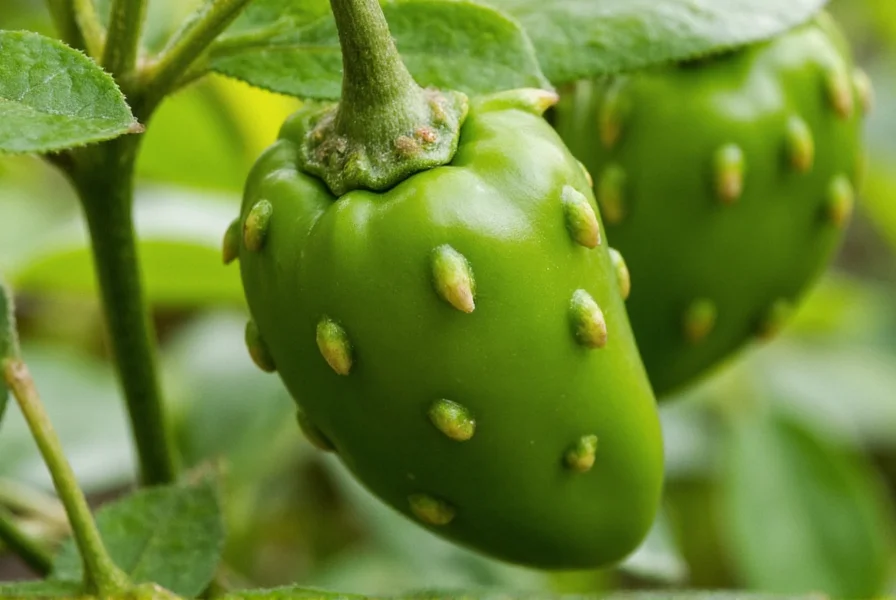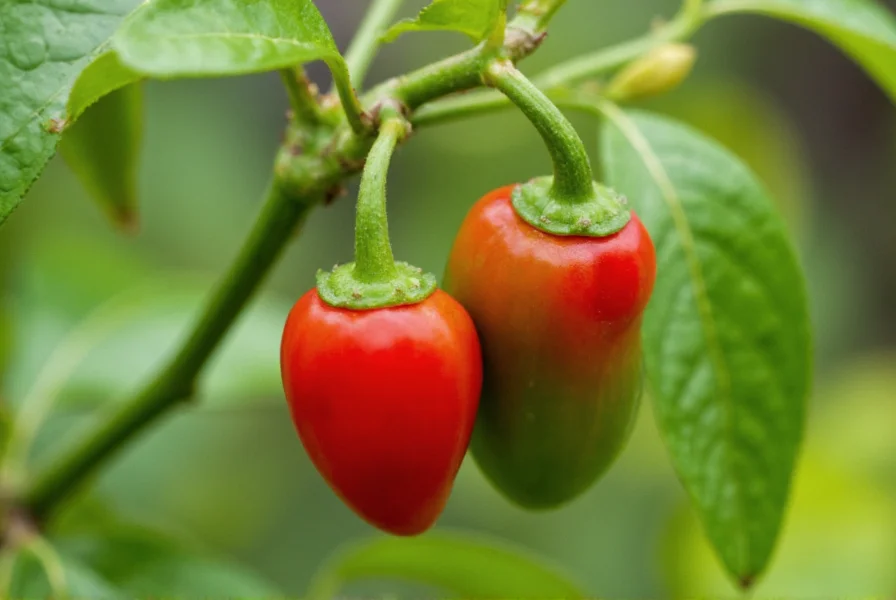The Moruga Scorpion pepper represents one of the most intense culinary experiences available to chili enthusiasts. This small but formidable chili consistently tests between 1.2 and 2.0 million Scoville Heat Units (SHU), placing it among the top three hottest peppers globally. Developed in the village of Moruga in Trinidad and Tobago, this pepper earned its "Scorpion" name from the distinctive stinger-like tail at the blossom end of each fruit.
Understanding Moruga Pepper Characteristics
Measuring approximately 1-2 inches in length, Moruga peppers display a characteristic bumpy, wrinkled skin that ranges from vibrant red to sunny yellow when fully mature. The plant itself grows to about 3-4 feet tall with dark green foliage, producing peppers that transition from green to their final color over 90-100 days. What distinguishes the Moruga Scorpion from other super-hots is its complex flavor profile—beneath the intense heat lies pronounced fruity, citrusy notes with subtle earthy undertones.

Heat Level and Scoville Measurement
When discussing moruga scorpion pepper heat level, researchers at.Winthrop University confirmed its position among the world's hottest peppers through rigorous laboratory testing. Unlike the Carolina Reaper which shows more heat variation, Moruga peppers maintain remarkably consistent heat levels across different plants and growing conditions.
| Pepper Variety | Scoville Range (SHU) | Heat Comparison |
|---|---|---|
| Moruga Scorpion | 1,200,000-2,000,000 | 400-800x hotter than jalapeño |
| Carolina Reaper | 1,400,000-2,200,000 | 450-880x hotter than jalapeño |
| Ghost Pepper | 800,000-1,041,427 | 250-350x hotter than jalapeño |
| Jalapeño | 2,500-8,000 | Baseline |
The heat progression of Moruga peppers differs significantly from other super-hots. Rather than immediate intense heat, Moruga delivers a delayed onset—approximately 30-45 seconds after consumption—followed by a gradual build to peak intensity that can last 20-45 minutes. This delayed reaction often catches inexperienced eaters by surprise.
Growing Moruga Peppers Successfully
For gardeners interested in how to grow Moruga peppers, these plants require specific conditions to thrive. They need 10-12 hours of direct sunlight daily, well-draining soil with pH between 6.0-6.8, and consistent temperatures between 75-90°F (24-32°C). The extended growing season (100-120 days to maturity) makes them challenging for cooler climates without greenhouse support.
Successful moruga scorpion pepper cultivation requires careful attention to watering—consistent moisture without waterlogging—and regular feeding with balanced fertilizer. Many growers report better yields when hand-pollinating the flowers, as the plants don't always self-pollinate effectively indoors. Harvest occurs when peppers develop their characteristic deep red or yellow color and slightly soften to the touch.
Culinary Applications and Flavor Profile
Despite its fearsome heat rating, the Moruga pepper offers remarkable culinary versatility. The moruga pepper flavor profile features tropical fruit notes of mango and citrus with subtle berry undertones, making it valuable for hot sauces, preserves, and specialty dishes where controlled heat is desired.
Chefs working with Moruga peppers typically use them in minute quantities—often just a few drops of infused oil or a small piece of pepper—to add complexity without overwhelming heat. The pepper's natural sugars make it particularly suitable for fruit-based hot sauces, where the sweetness balances the intense capsaicin. When properly handled, moruga pepper culinary uses extend beyond heat to provide distinctive flavor dimensions impossible to achieve with milder varieties.
Safety Considerations for Handling
Working with Moruga peppers requires serious precautions. The capsaicin concentration is high enough to cause chemical burns on skin and severe irritation to eyes and mucous membranes. Always wear nitrile gloves (latex won't protect against capsaicin) and eye protection when handling. Never touch your face during preparation, and work in a well-ventilated area as the volatile oils can become airborne.
If you experience capsaicin exposure, remember that water won't help—it actually spreads the oil. Instead, use milk, yogurt, or other dairy products to neutralize the burn, as the casein protein binds to capsaicin molecules. For skin exposure, a mixture of baking soda and vegetable oil creates an effective paste to draw out the oils.
Moruga Pepper vs Similar Super-Hots
When comparing moruga pepper vs Carolina Reaper, several key differences emerge. While both rank among the world's hottest peppers, the Moruga generally shows more consistent heat levels across different growing conditions. The Carolina Reaper displays greater variation, with some specimens significantly hotter than others.
Flavor-wise, Moruga peppers offer more pronounced fruitiness compared to the Reaper's distinctive candy-like sweetness. The heat progression also differs—Moruga delivers a slower, more building heat, while the Reaper often hits immediately with a sharper burn. For growers, Moruga plants tend to be more disease-resistant and productive than Reaper plants, which can be finicky.
Where to Source Authentic Moruga Peppers
Finding authentic Moruga Scorpion peppers can be challenging. Most commercial seed companies sell verified Moruga Scorpion seeds, but be cautious of mislabeled products. The best sources include specialty chili seed suppliers with verifiable growing histories and positive customer reviews.
Fresh Moruga peppers remain rare in mainstream grocery stores due to their extreme heat and limited commercial cultivation. Specialty farmers' markets in warmer climates occasionally carry them during peak season (late summer to fall). For most consumers, dried Moruga peppers or high-quality hot sauces featuring this pepper represent the most accessible options.
Conclusion
The Moruga Scorpion pepper represents both a challenge and opportunity for chili enthusiasts. Its combination of extreme heat and complex flavor makes it a prized ingredient for those seeking authentic super-hot experiences. Whether you're growing moruga scorpion pepper cultivation projects or experimenting with handling extremely hot peppers safely in the kitchen, understanding this pepper's unique characteristics ensures both safety and culinary success. As with all super-hots, respect for the pepper's potency combined with knowledge of proper handling techniques unlocks its remarkable potential.

How hot is the Moruga pepper compared to a jalapeño?
The Moruga Scorpion pepper measures between 1.2 and 2.0 million Scoville Heat Units (SHU), making it approximately 400-800 times hotter than a jalapeño, which ranges from 2,500 to 8,000 SHU. This means even a tiny amount of Moruga pepper can deliver intense heat that builds gradually over 30-45 seconds after consumption.
Can you grow Moruga peppers in a home garden?
Yes, you can grow Moruga peppers in a home garden with proper conditions. They require 10-12 hours of direct sunlight daily, well-draining soil with pH 6.0-6.8, and consistent temperatures between 75-90°F (24-32°C). The plants need 100-120 days to maturity, making them challenging in cooler climates without greenhouse support. Successful cultivation requires consistent moisture, balanced fertilizer, and often hand-pollination for best yields.
What's the difference between Moruga Scorpion and Carolina Reaper?
While both rank among the world's hottest peppers, Moruga Scorpion generally shows more consistent heat levels across different growing conditions compared to the Carolina Reaper's greater variation. Moruga offers more pronounced fruitiness with tropical notes, while Reaper has a distinctive candy-like sweetness. Moruga delivers a slower-building heat (30-45 second delay), whereas Reaper hits more immediately. Moruga plants also tend to be more disease-resistant and productive than Reaper plants.
How should I handle Moruga peppers safely?
Always wear nitrile gloves and eye protection when handling Moruga peppers, as capsaicin can cause chemical burns. Never touch your face during preparation and work in a well-ventilated area. If exposed, use dairy products (milk, yogurt) to neutralize burns, as water spreads the oil. For skin exposure, a baking soda and vegetable oil paste effectively draws out capsaicin oils.
What are the best culinary uses for Moruga peppers?
Due to their extreme heat, Moruga peppers work best in minute quantities—often just a few drops of infused oil or a small piece. Their tropical fruit notes make them ideal for fruit-based hot sauces, preserves, and specialty dishes where controlled heat is desired. The natural sugars balance well with sweet ingredients, creating complex flavor profiles impossible with milder peppers.











 浙公网安备
33010002000092号
浙公网安备
33010002000092号 浙B2-20120091-4
浙B2-20120091-4